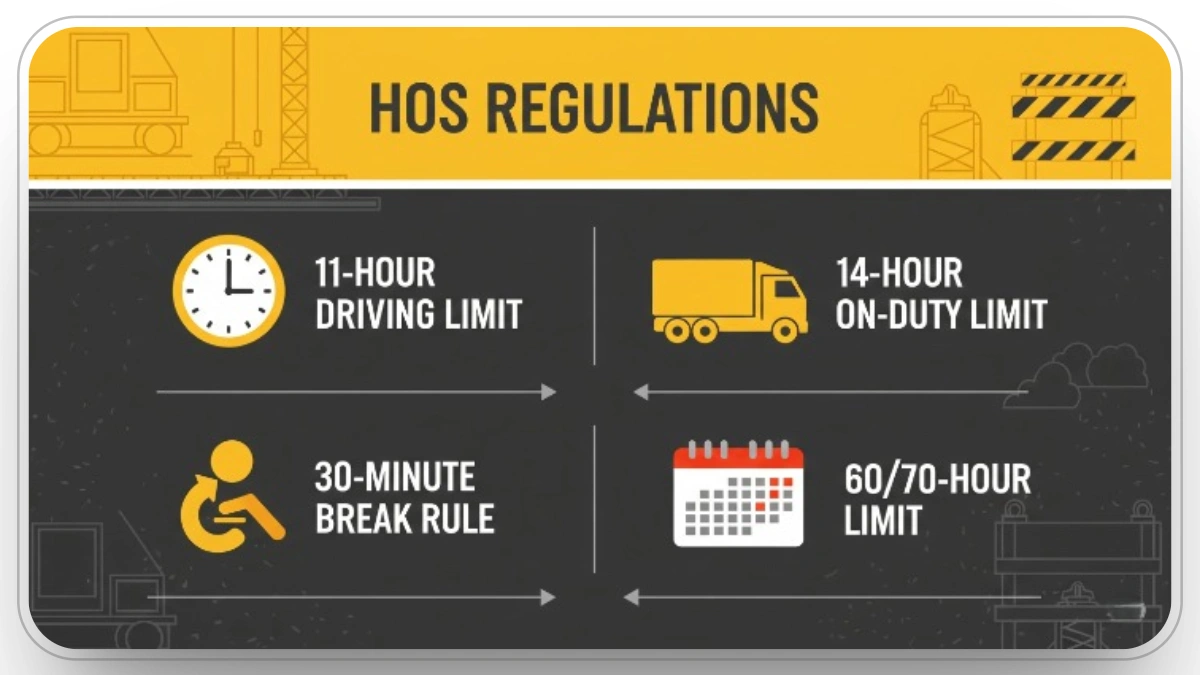HOS (Hours of Service) Tracking in Construction: Completely Explained
The Hours of Service (HOS) management is crucial in the construction sector with respect to safety and compliance issues. Although the rules on HOS are more likely to be referred to the transport and trucking markets, they can also be concerning construction workers who use commercial vehicles, especially when there is a need to transport equipment, material, or workers to the areas of construction.
As more attention to safety and regulatory compliance is being placed, it is more important than ever to know and enact appropriate means of tracking and monitoring HOS in construction operations.
This guide will comprehensively demonstrate what the HOS regulations are, who they apply to, the exemptions attainable to the industry and best practices in monitoring and maintaining compliance.
What are Hours of Service (HOS)?
.webp)
HOS regulations are put out by the Federal Motor Carrier Safety Administration (FMCSA) in order to limit the number of hours the drivers of commercial vehicles can be working. The guidelines are meant to prevent fatigue on the road, reduce incidents of accidents caused by overworked drivers and improve safety on the roads.
To the construction industry, HOS usually refers to a driver who delivers construction equipment, materials, and people to and around the job sites.
According to FMCSA a commercial vehicle is any motor vehicle that is involved in the transportation of people or goods in interstate commerce as well as a vehicle that carries a gross vehicle weight rating (GVWR) of 10,001 pounds or more. These encompass trucks, trailers and other equipment used in construction.
The rules severely restrict the number of driving hours, mandatory rest time, and off-duty times to make certain that the drivers do not overwork and chances of accidents connected with fatigue are reduced as much as possible.
HOS Regulations: Key Elements

There are some fundamental rules covered by the FMCSA in its HOS regulations, which impact the construction activities. The major regulations which drivers of commercial vehicles should take into consideration are as:
- 11-Hour Driving Limit: Drivers have to drive their vehicles not more than 11 hours after 10 previous hours off the duty. Once this is done, they are required to rest at least 10 hrs and go back to driving.
- 14-Hour On-Duty Limit: A driver cannot have an accumulation of more than 14 consecutive hours on duty after going on duty. These consist of all the activities, which include driving, loading and unloading, and/or any other activity to do with the job. The driver should have a break after 14 hours.
- 30-Minute Break Rule: Drivers must adopt a 30-minute rest period in the event that they have driven for eight hours straight. And during this break, there must be no duty, the driver should be entirely off-duty, and he or she is free to carry out other non-interfering activities.
- 60/70-Hour Limit: Within seven days, drivers are allowed to work a maximum of 60 hours per week. This limit goes as high as 70 hours within eight days. Beyond this, the driver is required to have 34 consecutive off duty in order to reset the weekly number of hours.
Exemptions for the Construction Industry
Although the FMCSA regulations are liable to the person operating construction equipment, there are exemptions and considerations to be taken in construction related operations. The goal is to lessen the regulatory encumbrance, and the construction industry is distinctive in its operational requirements.
- Short-Haul Exception: This exemption exonerates motorists that work in an air radius of 150 miles to their port of duty in relation to the requirement of maintaining a record of duty status (RODS). They also may not require the electronic logging device (ELD) requirement when a driver arrives back to her or his place of work within 14 hours of going on duty. It is especially advantageous to the local construction work which does not require lengthy driving.
- Ready-Mix Concrete Exemption: Ready-mixed concrete drivers do not undergo the 30-minute break provided they are waiting at a construction site. Time that is spent waiting at the job site can be categorized as total break time, but it should not be accompanied by any other work that the driver is doing during this time.
- 24-Hour Restart: A 24-hour restart limit is permitted by construction workers operating within 75-air-miles radius of their plant. This exemption gives drivers an allowance to reset their 60/70-hour duty cycle, after spending 24 hours in a row off duty. It is particularly helpful to workers in the construction industry who have large-scale tasks and have to be able to afford greater flexibility in their work hours.
Why is HOS Tracking Important in Construction?

HOS tracking is not a mere legal requirement but a need regarding safety, efficiency and overall success of the project. Some of the reasons that HOS tracking is such an important tool in construction include the following:
- Safety and Fatigue Prevention: In the commercial vehicle industry, fatigue is the main cause of accidents. Drivers and operators of construction equipment can avoid accidents that may otherwise be caused by driver fatigue- which can lead to delay, injury, and most assuredly death- by following HOS rules.
- Regulatory Compliance: Non-compliance or inability to track HOS requirements may lead to expensive fines, penalties and even closure of construction activity. Regular HOS monitoring enables companies to be in compliance with the FMCSA rules and regulations and prevents legal problems.
- Resource Optimization: With proper tracking equipment operators and drivers will not be overworked hence enabling them to be productive and very efficient throughout the working period. This way you can ensure that the health and well-being of your workforce is maintained and that it prevents costly mistakes and delays.
- Enhanced Accountability and Transparency: HOS tracking also gives managers a real understanding of how many hours their employees work so they would be in a better position to manage the operations on field and transportation logistics. This type of transparency helps avoid the problem of overworking or staff burnout.
HOS Challenges in Construction Industry
There are new barriers in implementing HOS tracking in the construction industry that is not normally encountered in long-haul trucking:
- Variable Jobsite Schedules: When compared to stable freight routes, construction jobs change day-to-day, where the drivers drive on short and odd trips.
- Limited Tech Adoption: Smaller companies cannot spend or are inexperienced enough to use ELDs or telematics adequately.
- Driver Resistance: The armed forces used to paper register or even spontaneous behaviors might not adopt well-organized tracking quickly.
- Fleet Composition Complexity: The complexion of a combination of CDL and non-CDL cars makes implementing a universal HOS policy.
- Remote or Rural Sites: The poor coverage of cellular signals will impede the delivery of real-time updates given by ELDs or GPS trackers.
Such obstacles notwithstanding, technology solutions such as Clue may lower the friction connected with ELD data incorporation and make reporting and other tasks easier and provide team members with a single dashboard that allows them to monitor compliance.
Penalties for HOS Non-Compliance

Even construction firms can suffer dire financial and operation consequences in case of noncompliance with FMCSA HOS requirements:
- Fines and Civil Penalties: The fines can be as much as 16,000 dollars per violation, particularly in the cases where safety is undermined.
- Out-of-Service Orders: This can result in the pulling off drivers without them making it to their obligatory rest-periods, which amounts to delays at prohibitive expenses.
- Audit Risk: Consecutive offenses can lead to further investigation on the company safety records by regulators and subsequent over-scrutiny.
- Increased Insurance Costs: Failure to comply tends to cost them dearly in terms of an increase in liability insurance premiums owing to lower safety ratings.
- Reputation Damage: HOS violations alone, or when connected to accidents, will destroy customer confidence and project-bidding in the future.
Effective HOS tracking and training will help avoid such problems before they happen and keep your projects going and protect your drivers.
How Clue Supports HOS Tracking in Construction
Clue is a construction equipment management software that incorporates different elements of the fleet operations such as HOS compliance into a single pane of glass.
Key Features for HOS Compliance
- Integration with Telematics Systems: Clue connects to other telematics, which helps to get information on vehicle movement and functioning. It will integrate records to logged time on the road and helps with HOS compliance.
- Maintenance and Inspection Management: The platform provides scheduling and tracking maintenance modules for inspections and work orders. Routine check-ups and service can be important considerations to bear in mind to make sure that vehicles are in good working order and may facilitate compliance with the HOS regulations by avoiding a surprise maintenance.
- Dispatch Management: Clue has dispatch management tools that enable effective management of time and resources. Through enhanced optimization of dispatch-related activities, construction companies will be able to better coordinate driving hours and thus minimize the occurrence of HOS.
- Real-Time Fleet Visibility: Clue can provide real-time information about the fleet, including its use of equipment, idle time and location. This visibility allows fleet managers to understand working hours, the amount of time a driver spends on the road, and ensure that HOS regulations are being followed.
Best Practices for Implementing HOS Tracking in Construction

With the introduction of technology, it is easy to track HOS in construction activities. Modern tools and solutions allow construction businesses to optimize HOS compliance in order to build safety across their workforce.
The following are some of the best practices in such implementation of HOS tracking systems:
1. Use Electronic Logging Devices (ELDs)
The Electronic Logging Devices (ELDs) can be considered one of the best methods to monitor HOS compliance in the construction sector. ELDs automatically track the time the driver spends on the road, his or her work time, and the rest time. The devices are a great way of eradicating the chances of human error, and guaranteeing that logs are accurate and updated.
ELDs are particularly useful in construction activities involving drivers who move their equipment and materials into jobs as well as out of jobs. The FMCSA requires ELDs to be installed on drivers who have met specific qualifications (i.e. interstate drivers). Even in the case of construction companies that do not have to utilize ELDs, using such devices may be a good investment to stay safe and compliant.
2. Leverage GPS and Telematics Systems
Apart from ELDs, there is also the possibility of tracking locations, speeds and overall vehicle performance using GPS tracking and telematics technology. Such systems give the construction vehicles real-time information on the functioning of the vehicle thus assisting managers to determine whether there is a possible safety risk, when there is need to monitor the driving style, and whether the driver is following the scheduled stopovers and rest periods.
Telematics also assists with efficiency by offering useful information on fuel consumption, vehicle condition, and the service it requires.
The use of GPS and telematics systems alongside the HOS tracking instructions enables businesses to have a concise overview of both the activity status of the driver as well as the performance of the vehicles in a single platform so that they can effectively track the whole fleet.
3. Adopt HOS Compliance Software
Hours of Service Compliance Software can be another useful solution for construction businesses. These software solutions can provide resources to manage HOS compliance by tracking HOS compliance, maintaining driver logs, and reporting everything to managers in an easily reviewed way. The software can even provide alerts while drivers approach, or exceed, their legal driving limits so any corrective measures can occur.
Another advantage of Hours of Service Compliance Software is that it can interface or integrate software, providing a dashboard that summarizes HOS and operational data. If all data can be managed in one, easy to view source, work and monitor will be easier for fleet managers.
Monitoring the broad nature of the fleets performance include synergy in tracking driver safety, vehicle preventative maintenance schedules, and compliance when monitoring the safe driving behavior of individuals.
4. Training and Education
It is critical that the drivers and staff in your company are trained about HOS regulations and their implications for any and all on-road driving to help ensure proper HOS compliance.
Training should include driver education on the proper use of ELDs, GPS, and telematic systems as well as adherence to rest breaks and HOS limits for their areas of defined responsibility (i.e., for individual drivers, workers, and transport units, and their environments).
5. Monitor and Review Logs Regularly
Monitoring HOS logs is a very important requirement of compliance.
Managers should establish and maintain a consistent schedule for routine and regular reviews of driver's logs that will help reveal which drivers are in violation of HOS limits, and which ones are taking the rest breaks that are required.
The earlier violations are revealed, the earlier managers can plan to deal with the violation before it becomes a bigger issue.
Conclusion
HOS tracking is serious business when it comes to construction work, particularly when that work involves moving, delivering, transporting and handling equipment/materials to and from jobsites.
Through knowledge of the HOS regulation, leveraging today’s technology including ELDs, GPS systems, telematics best practices to ensure compliance, construction firms can continue to keep operations running efficiently and safely, while meeting regulations.
Construction companies can use fleet management software to help eliminate fatigued drivers, and avoid non-compliance with the consequence of driver fatigue. As more HOS regulations continue to develop and change, the importance of being a part of that evolution for construction managers is clear. However, it will also benefit construction companies in their end result of completing work in a safe and compliant manner.
Transform Your Equipment Management












